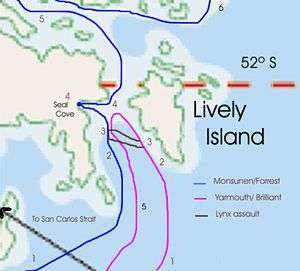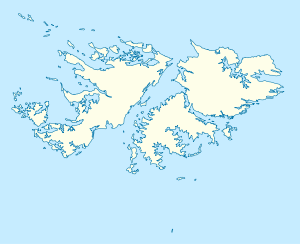Battle of Seal Cove
The Battle of Seal Cove was a minor naval action west of Lively Island, during the 1982 Falklands War. On 22 May 1982, while supporting Operation Sutton off San Carlos Bay, the British frigates HMS Brilliant and HMS Yarmouth received orders to stop and seize the Argentine Navy armed coastal supply boat ARA Monsunen.
| Battle of Seal Cove | |||||||
|---|---|---|---|---|---|---|---|
| Part of Falklands War | |||||||
 Sketch depicting the chase of the Argentine coastal vessel Monsunen by British frigates Details
| |||||||
| |||||||
| Belligerents | |||||||
|
|
| ||||||
| Commanders and leaders | |||||||
|
Captain Anthony Morton (HMS Yarmouth) Captain John Coward (HMS Brilliant) |
Captain Jorge A. Gopcevich-Canevari (ARA Monsunen) | ||||||
| Strength | |||||||
|
1 Type 22 frigate 1 Rothesay-class frigate | 1 armed coastal ship | ||||||
| Casualties and losses | |||||||
| None |
1 coastal ship beached (later taken in tow and rescued by ARA Forrest) 1 wounded | ||||||
 Location within Falkland Islands | |||||||
The ARA Monsunen was actually a 326 ton British coaster vessel owned by the Falklands Islands Company that had been captured in the course of the Argentine invasion. The ship was spotted by a Royal Air Force Hawker Siddeley Harrier[1] while sailing from Fox Bay towards Stanley with a cargo of 150 drums of fuel and 250 sacks of flour.[2]
The engagement
At 4:00 am GMT on 23 May,[3] a Lynx helicopter from HMS Brilliant identified Monsunen while the latter was heading to the north, west of Lively Island. After a surrender order was radioed to the motorboat, another helicopter transporting a SBS team tried to intercept her. The aircraft was greeted with heavy machine gun and small arms fire, so it was forced to abort the mission.[4][5] At the same time, the coastal ship's radar detected the British squadron about eight miles (13 km) to stern and approaching aggressively.[2]
Almost immediately, HMS Yarmouth began to fire her 4.5-inch (114 mm) deck gun on the Argentine vessel, forcing her to manoeuvre in order to avoid the incoming rounds. When the distance fell to four nautical miles (7.4 km), Captain Gopcevich, the Argentine commander, decided that the only way to deceive the British radar was to beach the boat on Seal Cove, a large inlet nearby.[1][2]
Shortly after he succeeded in running aground his ship and ordering the crew to abandon her, the British shelling resumed. The fire was inaccurate and aimed at the general area of landing. In the process of evacuating the vessel, one of the ratings fell overboard and suffered some serious bruises, but he was successfully rescued by a young sailor.[6] The crew members took refuge in an improvised inland shelter.[2]
Aftermath
After effectively losing the track of their small enemy, the British frigates gave up and returned to San Carlos waters.[1][7] Monsunen was found by her complement at dawn, with her engine still running; apparently after refloating by the rising tide. However, a sling had become entangled with her propeller, disabling the transmission.[2]
With the ship's speed now dramatically reduced, Gopcevich radioed for help to Stanley.
A few hours later, another British trawler seized by the Argentines, ARA Forrest, towed Monsunen to Darwin.[4] The much needed cargo was uploaded by ARA Forrest, which made for Stanley. The coaster successfully completed Monsunen's relief mission on 25 May.[2] ARA Monsunen was later recovered at Darwin by British forces on 29 May, after the Battle of Goose Green.[8]
The action is thought to be the only naval encounter between armed surface ships in the war.[9] Jorge Gopcevich Canevari was awarded the La Nación Argentina al Valor en Combate cross.[10]
Notes
- Freedman, p. 473
- Mayorga, pp. 378-380
- Freedman, Lawrence (2005) The Official History of the Falklands Campaign: War and diplomacy. Volume 2. Routledge, p. 473. ISBN 0714652075
- Smith, p. 81
- The improvised ship's gunners were an army sergeant and a conscript who served the 12.7 mm machine gun that shot at the Lynx. The Argentine crew claim that the helicopter's fuselage was hit by the tracer bullets.(Webpage with some photos of the ship and her crew) (in Spanish)
- This serviceman was honored with the highest Argentine Congress decoration after the war. He committed suicide in January 2006.Clarín newspaper, 26 January 2006 (in Spanish)
- In the case of Brilliant, she was later ordered to rejoin the main Task Force group, east of the Falklands, for refueling. (HMS Yarmouth: Captains Diary Archived 21 March 2009 at the Wayback Machine)
- Southby-Tailyour and Clapp, p. 247
- Naval-History.net
- Cavalieri, Daniel (2005). Deuda de sangre: historia naval y amnesia en la Argentina : 1810-1893 y 1982. Instituto de Publicaciones Navales, p. 357. ISBN 950-899-060-0 (in Spanish)
References
- Mayorga, Horacio A. (1998). No Vencidos. Ed. Planeta, Buenos Aires. ISBN 950-742-976-X (in Spanish)
- Freedman, Lawrence (2005). The Official History of the Falklands Campaign. Routledge. ISBN 0-7146-5207-5
- Smith, Gordon (2006). Battle Atlas of the Falklands War 1982 by Land, Sea and Air. Lulu.com. ISBN 1-84753-950-5
- Southby-Tailyour, Ewen and Clapp, Michael (1996). Amphibious Assault Falklands: The Battle of San Carlos Water. Leo Cooper. ISBN 0-85052-420-2
- "Falkland Area Operations, 22nd-23rd May 1982"
- Apostadero naval Malvinas (in Spanish)